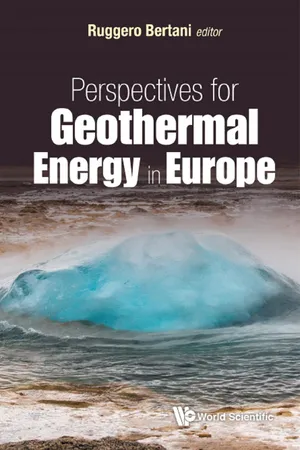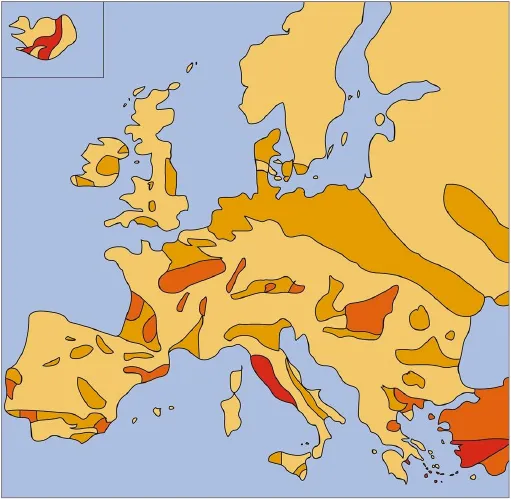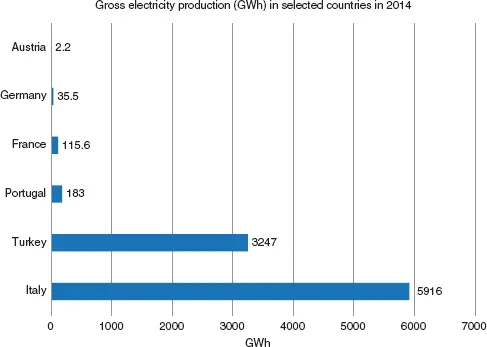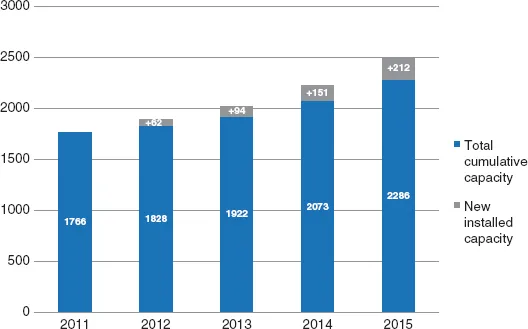![]()
Chapter 1
Geothermal Energy in Europe
Philippe Dumas
European Geothermal Energy Council
2 Place du Champ de Mars, B-1050 Brussels
[email protected] Geothermal development in Europe dates back to more than a century, but the market is still at the infancy stage. We have witnessed within the last five years a resurgence of interest in geothermal power, after nearly a decade of only small development in capacity in the deep geothermal sector both for electricity and for direct uses (mainly district heating). A substantial number of projects have been developed throughout Europe, and geothermal energy is on its way to become a key player in the European energy market.
The current market conditions do not allow this development; many nontechnical barriers still need to be removed. A new generation of geothermal technologies is also needed for answering the challenges of the next decade for the European energy system. If the energy transition has to be successful, we have to think about an optimal scenario in terms of costs and affordability for the customers and the citizens.
Geothermal will be a key enabler, a local and stable source of renewable energy, and its role will be crucial in the future energy system.
1.1.Introduction
Geothermal is a unique source of energy. Geothermal energy and Europe have a long history of developing together. In Europe, geothermal energy is the source of both electrical power for a century and heating and cooling for hundreds of years. It is one of the renewable energy sources. But both its capacities and its development in Europe make it quite unique. Geothermal is able to answer the challenges for the future European energy market design being capable to produce as base load electricity production and as a flexible power generation. Geothermal is also able to provide heating and cooling solutions for the building sector and the industry. Its past and current developments make this technology rather unique. It has typical barrier, notably economical such as its very high capital intensity and its risk profile; and legal such as the regulatory procedures for underground development in the different European countries.
Geothermal is officially defined, since 2009, by the institutions of the European Union (EU), in the Directive on Renewable Energy Sources (2009/28/EC) as the following: “geothermal is the energy in form of heat beneath the surface of the earth”.
Geothermal energy is the heat from the Earth, or, more precisely, that part of the Earth’s heat that can be recovered and exploited by man. Evidence of terrestrial heat is given by volcanoes, hot springs, and other thermal manifestations. Earth’s temperature is increasing with depth, under a gradient of 2–3°C/100 m. The total heat flux from the Earth’s interior amounts to ca. 80 MWth/m2. It provides us with an abundant, renewable, almost infinite source of energy.
However, only a fraction of it can be utilized by people. Our utilization of this energy has been limited to areas in which geological conditions allow a fluid (liquid water or steam) to “transfer” the heat from deep hot zones to, or near, the surface, thus giving rise to geothermal resources.
In Europe, as detailed in the following chapters, the potential to develop geothermal is huge. It was first exploited during ancient times, by the Greeks and the Romans, for its capacity to produce heating and cooling for recreational purposes such as spas and bathing. Until the 12th century, geothermal energy was indeed mainly exploited as direct uses for leisure and sometimes for the agro-food production. Power production and heating and cooling applications in the buildings sectors from geothermal started during the last century.
As presented in the map (Figure 1.1), geothermal energy can be developed all over Europe. The regions with high enthalpy (in red) are eligible for power production. Areas with medium enthalpy (in orange and dark yellow) can be used for the installation of power plants running at low temperature (binary plants) and of direct uses applications such as district heating (DH) systems. Finally, the rest of Europe (light yellow) is eligible for a power generation with engineered/EGS and for a heating and cooling production assisted with heat pumps. All these areas can also be exploited for underground thermal energy storage (UTES).
Figure 1.1Map of geothermal energy in Europe (EGEC).
The fight against climate change and its translation into international agreements within the United Nations Framework Convention on Climate Change (UNFCCC) require Europe to decarbonize its economy. The energy transition toward a low or a zero carbon energy has already started. The next five to 10 years will be crucial for designing the future energy mix if we wish to answer the 2050 climate and energy challenges. It means that the current period is key for deciding about future development of geothermal production in 2020, 2030, and 2050. The European geothermal sector must demonstrate its abilities to be a key answer to these global challenges.
Today, the geothermal contribution to the total energy consumed in Europe is relatively small, except for electricity in Italy and for heating in Sweden. Geothermal technologies still need to be supported (not always financially) for a certain period of time in terms of research, development, and innovation toward the next generation of geothermal technologies being EGS or smart thermal grids. A support is also needed for the market uptake of technologies at a precommercial stage or those already competitive but suffering from unfair market conditions. Geothermal energy should be able to develop enough by 2020 for convincing European decision makers of its potential contribution to the future energy mix.
Two of the main factors hampering the development of geothermal in Europe are that its advantages are not highlighted enough and still many barriers need to be removed.
1.1.1.Current Situation: 2015–2016
When looking at the current situation for the geothermal market development, we notice a mixed picture:
- The geothermal DH sector is developing.
- The situation for geothermal electricity has also developed quite well recently, especially in Turkey, with preparation times being longer than expected in the EU countries.
- For shallow geothermal, the development is not satisfactory at all, with several factors hindering the desired growth.
1.2.The Geothermal Power Production
There are 88 electrical power plants in Europe representing a total installed capacity of 2285 MWe and a production of around 12 TWh of electric power (Figure 1.2).
Geothermal plants in Europe are characterized by a high availability (amount of time that a plant is able to produce electricity over a certain period, typically a year, divided by the amount of the time in the period, i.e., 8765–8766 h) and net capacity factor (the ratio of the actual output of the geothermal plant over a period of time, to its potential output if it were possible for it to operate at full nameplate capacity indefinitely), typically in excess of 80%. Some geothermal plants operate at 100%.
Figure 1.2Graph of geothermal power production in Europe in 2014 (EGEC, 2015).
The average growth rate for the last five years is of 5%, with around five to ten new power plants inaugurated per year representing an annual new capacity installed of about 100 MWe (Figure 1.3).
It is important to highlight that more than 200 projects are currently under development or investigation, and it means that the number of plants operating in Europe could double in the near future. But the geothermal power market is not developing as quickly as expected. There are three main reasons for this:
- First, the vast geothermal potential is still underestimated and thereby there is an urgent need to increase awareness of its advantages especially for decision makers and investors.
- Second, much more financial support should be brought to the geothermal sector. Support schemes are crucial tools of public policy for geothermal to compensate for market failures and to allow the technology to progress along its learning curve. Funding allocated to geothermal energy is negligible compared to that which is allocated to other technologies.
- Finally, beyond exploration, the bankability of a geothermal project is threatened by the geological risk. Risk insurance funds for the geological risk already exist in some European countries (France, Germany, Iceland, the Netherlands, and Switzerland). The geological risk is a common issue all over Europe. Collaboration between member states is desirable; it can allow them to save money and trigger the uptake of a valuable technology alike.
Figure 1.3Graph of cumulated installed capacity in Europe 2011–2015 (EGEC, 2015).
The main geothermal markets for electrical generation in Europe are Turkey, Italy, Germany, and France. Today, Italy continues to dominate the market but Turkey is the hottest market and more than 50% of the projects under development representing a capacity of around 650 MWe by 2017 are planned in this country. France and Germany already have a few geothermal power plants in operation and many permits have been requested and granted. These countries can now be seen as future hot markets, especially regarding low-temperature production and EGS.
Kizildere geothermal field was the first field utilized in 1974 for electricity production in Turkey. The Kizildere pilot plant had a capacity of 0.5 MWe. Larger-sized power production in Kizildere started in 1984 with increased installed capacity of 15 MWe. New geothermal power plants have been installed since 2006 with a real boom between 2009 and 2015. Finally, it is worth mentioning that a significant number of licenses have been granted by the Energy Market Regulatory Authority (EMRA) of Turkey. The total installed capacity may further grow until around 1 GWe by 2020. Turkey is therefore set to overtake Italy as the leading European geothermal country in terms of installed capacity by the end of the decade. After the liberalization of the Turkish electric market, many players are now conducting exploration activities, preparing the basis for the future development of geothermal energy in Turkey.
It can be noted that all projects are developed by Turkish project developers; some are in consortium with a foreign companies (co-project developer, equipment providers, utilities, turbines providers etc.).
Italy still represents more than 50% of the European capacity with around 915 MWe installed capacity today in Tuscany. Some new plants are currently being developed and should become operational by 2020.
A Legislative Decree (No. 22 of February 11, 2010) has liberalized access to the geothermal market, allowing new players to enter into the geothermal business by applying to the regional authority for an exploration lease. In recent years, several new leases have been requested in many different Italian regions.
More than 130 requests for research permits regarding geothermal exploration and exploitation have been presented in the last couple of years. Of these, 50 have been granted, 37 of which are in the Tuscany region, and around 40 under evaluation.
France is the real new hot market in Europe with a particular focus on EGS. Geothermal electricity has been produced in France since 1986 at the Bouillante 1 plant in Guadeloupe (double flash of 4 MWe). This plant has been extended by 11 MWe with Bouillante 2 inaugurated in 2005. The total capacity is currently 14.7 MWe and the production is about 80 GWh. Plant extension with Bouillante 3 is under development. Most activities today are in Alsace. The Soultz-Sous-Forˆets power plant has a net capacity of 1.5 MWe for net production, after 25 years of research and about €80 million of investment.
The...



